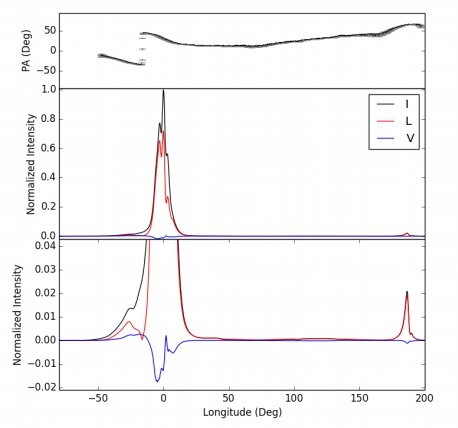Using the Five-hundred-meter Aperture Spherical radio Telescope (FAST), astronomers from the Chinese Academy of Sciences (CAS) and elsewhere have conducted single-pulse observations of a pulsar known as PSR B1929+10. Results of the monitoring campaign shed more light on the periodic and phase-locked modulation in this source. The study was presented in a paper published December 18 on arXiv.org.
Pulsars are highly magnetized, rotating neutron stars emitting a beam of electromagnetic radiation. Some of them showcase variability in emission ranging from extremely short bursts like giant pulses to long-term changes in their emission profiles. In some cases, mode changing has been observed in which the emission profile switches between two or more quasi-stable modes of emission.
At a distance of some 1,177 light years, PSR B1929+10 (also known as PSR J1932+1059) is one of the nearest pulsars. It has a spin period of 226.5 ms and spin-down age of approximately 3.1 million years. The integrated pulse profile of this source exhibits both a main pulse (MP) and an interpulse (IP) – features usually thought to be pulsar emission from two opposite magnetic poles.
In order to get a better understanding of the emission properties of PSR B1929+10, a team of astronomers led by Feifei Kou of the CAS Key Laboratory of FAST in Beijing, China, has carried out single-pulse observations of this pulsar. The observational campaign lasted from September 2018 to November 2019 and resulted in obtaining more than 20,000 single pulses of PSR B1929+10 using FAST.
“We exploited the largest single dish telescope FAST to make single-pulse observations of this pulsar. The high sensitivity observations of PSR B1929+10 with FAST reveal previously unknown and more complex emission properties, which may further complicate our understanding of radio emission in this pulsar,” the astronomers explained.
The observations found that the weak IP of PSR B1929+10 shows clear pulse-to-pulse modulation. Results indicate that both the MP and IP are modulated by a period of about 12 times the pulsar’s rotational period. It was confirmed that it is a periodic amplitude modulation, given that there are no obvious subpulse drifting features detected in the data obtained by FAST.
According to the study, the periodic amplitude modulation in the IP turned out to be anti-correlated with that in the weak preceding component of the MP (designated MP I), however it was found to be correlated with that in the first two components of the MP (MP II). The astronomers noted that this suggests that the modulation patterns in the IP and the MP are phase-locked.
Moreover, it was found that the modulation in the first two components of the MP is delayed compared to that in the IP by about one rotational period of the pulsar. The results confirm that the separation between the IP and the MP is independent of radio frequency and that weak emission exists between the MP and the IP.
Summing up the findings, the astronomers concluded that they pose a challenge to the existing pulsar theories.
“Observations of PSR B1929+10 with FAST represent a conundrum for pulsar theories and cannot be satisfactorily explained by the current pulsar models. Much work still needs to be done to fully understand pulsar radio emission and the structure of neutron star magnetosphere,” the authors of the paper wrote.
Study investigates mode switching phenomenon in the pulsar PSR J1326−6700
More information:
Periodic and Phase-locked Modulation in PSR B1929+10 Observed with FAST, arXiv:2012.10156 [astro-ph.HE] arxiv.org/abs/2012.10156
2020 Science X Network
Citation:
Periodic and phase-locked modulation in the pulsar PSR B1929+10 investigated with FAST (2020, December 28)
retrieved 29 December 2020
from https://phys.org/news/2020-12-periodic-phase-locked-modulation-pulsar-psr.html
This document is subject to copyright. Apart from any fair dealing for the purpose of private study or research, no
part may be reproduced without the written permission. The content is provided for information purposes only.



